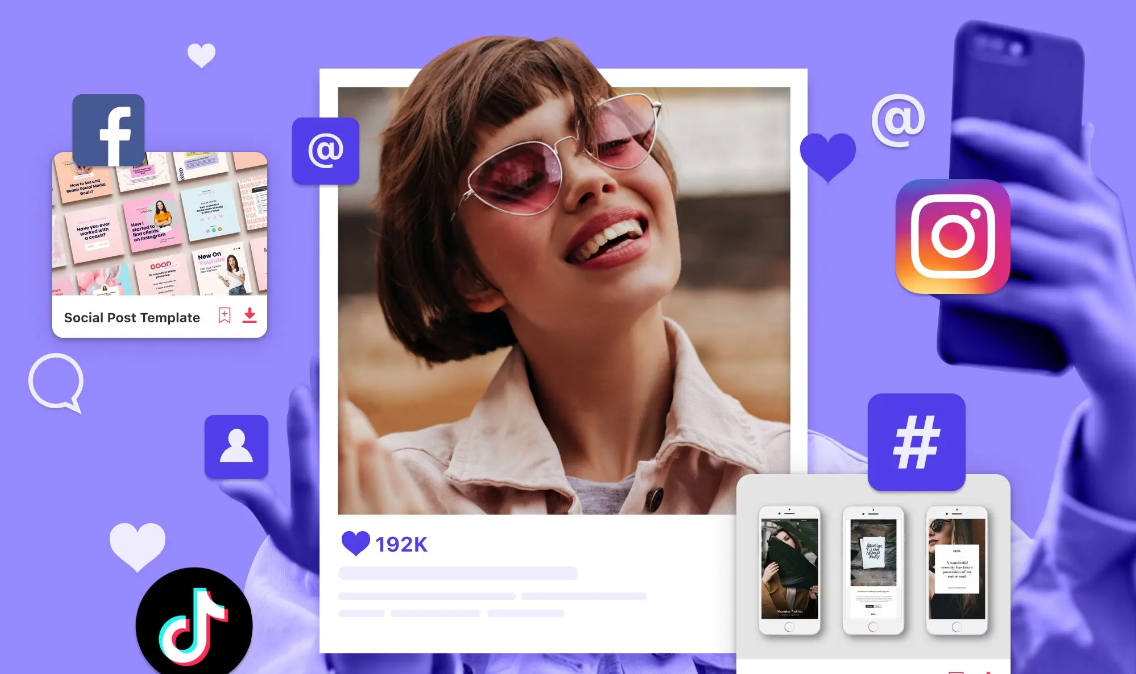Influencer marketing is a rapidly growing industry. In 2024, the spending on influencer marketing was $8.14 billion. It grew over three times faster than social ad spending and, that trend is expected to remain ahead in 2025 and beyond. As the industry evolves, the key performance indicators, content goals and campaign formats that defined the previous year’s success may not be as powerful and relevant in 2025.
This article has compiled a comprehensive list of the top influencer marketing stats and trends to help you stay up-to-date with the latest industry tips. The list will give you a snapshot of the state of the industry, the most popular social platforms and what it takes to create effective influencer marketing campaigns.
Influencer Marketing Growth Stats
Influencer marketing has been on a steady rise over the years, showing no signs of stopping. The following influencer marketing growth statistics can help you to learn more about the sector and its future projections for social media.
The influencer marketing industry was valued at $24 billion in 2024
The influencer marketing industry was worth an estimated $1.7 billion in 2016. It rose to $16.4 billion in 2022 and surged to $24 billion in 2024. That exponential growth shows the industry is in good health and could expand further.
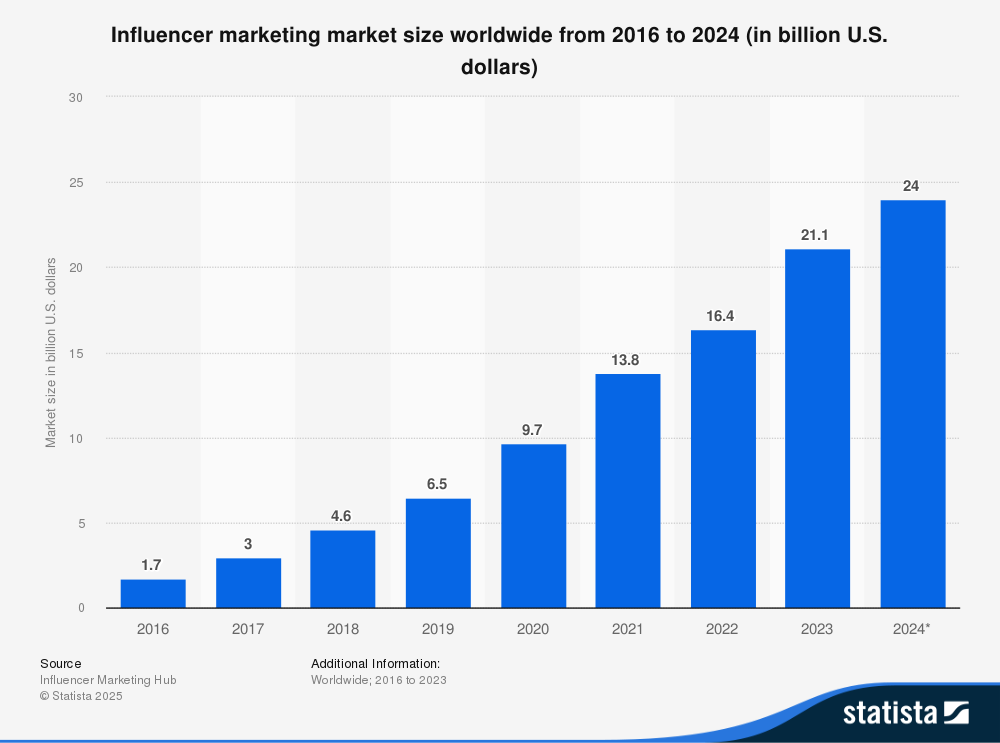
86% of Marketers in the US will partner with influencers in 2025
Almost 70% of US marketers in companies with 100+ employees were expected to use influencer marketing in 2021. That figure has seen a steady rise ever since and is expected to reach 86% in 2025.
26% of marketing agencies and brands allocate over 40% of their marketing budgets to influencer marketing globally
As of February 2024, 26% of marketing agencies and brands around the globe have allocated over 40% of their marketing budgets to partnerships with influencers. It is surprising that 26.1% of marketing agencies and brands allocated less than 10%. Both of those percentages grew year-on-year. That could hint at a growing polarization in opinion regarding influencer marketing budgets.
Instagram is the world’s leading influencer marketing platform
More than half of brands (about 57%) view Instagram as their preferred social media platform for influencer campaigns. TikTok comes in second, used by about 52% of brands. 37% of brands prefer YouTube with 28% and 12% using Facebook and LinkedIn respectively.
The global influencer marketing industry could reach $33 billion in 2025
Influencer marketing platforms help with finding influencers and connecting them with brands, developing contracts, planning campaigns and other activities. Thus, it is not surprising that the market size is also growing and projected to hit $33 billion in 2025.
Effectiveness Statistics
So much goes into an effective influencer marketing campaign. Getting the right niche influencers, reaching the right audiences and choosing the right content format and briefing strategy can be a gamble. The following influencer marketing effectiveness statistics will help you to narrow down what makes a successful campaign.
Influencers prefer working with brands on short-form videos, product collaborations and giveaways
More than half of influencers prefer short-form videos between 15-30 seconds long, with just a handful opting for evergreen activations.

65% of influencers want to be involved in the creative process
Sprout Social 2024 Influencer Marketing Report established that 65% of influencers want to be involved in creative or products development processes with brands early on than follow scripted briefs. Influencers are strongly aligned with the nuance of culture and understand the angles that will resonate with their audiences.
Influencer Marketing ROI Stats
The budgets for influencer marketing are at an all-time high. And the big question is, what do brands get out of their influencer campaigns? The following are some influencer marketing ROI stats, based on a recent report by Sprout Social.
Long-term relationships between brands and influencers help to cut costs
According to a 2024 Influencer Marketing Report, half of influencers charge between $250 to $1,000 per post. However, 71% provide discounts for long-term partnerships with another 25% willing to consider doing that in the future. That emphasizes the value of long-term partnerships between brands and influencers.
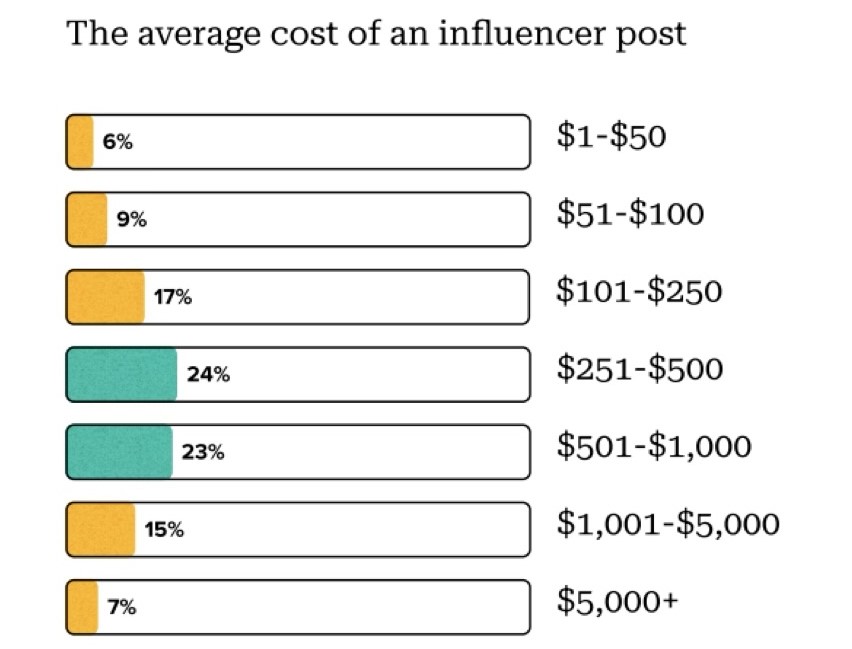
86% of consumers make a purchase inspired by an influencer at least once a year
Survey responses in the Buying Behaviors section of the above report show 16% of consumers rank influencer marketing as having the most significant impact on their purchasing decisions. However, influencer content drives about half of the purchases that consumers make daily, weekly or monthly. Besides, about 86% of consumers make purchases inspired by influencers at least once a year.
64% of consumers believe genuine reviews are the most effective influencer content type
Genuine customer reviews and discount codes are the top influencer content qualities that compel users to make purchases from a brand. That indicates a successful influencer campaign plan in 2025 should entail asking influencers with an audience overlap in the same category to provide genuine reviews and exclusive promotions to their audiences.
62% of frequent buyers are likely to share product feedback with influencers
Influencer marketing ROI is not limited to increased web traffic and conversions. According to buyer insights from a 2024 Influencer Marketing Report, 29% of all consumers are likely to share product feedback with influencers. That figure surges to 41% for Gen Z consumers and 62% for frequent buyers.
That shows consumers are bringing influencers into the product feedback avenue. If your care teams and marketers are not working closely with influencers to capture and address this feedback, you are missing out on valuable consumer insights.
B2C brands work with multiple influencers at a time
Most studies show B2C brands tend to partner with more influencers at a time, with an estimated 52% partnering with 6-10 influencers at a time and, 23% partnering with 11 to 19.
Top Influencer Marketing Trends for 2025 and Beyond
Influencer marketing trends are constantly evolving and, what clicked with the average social media user last year may already be old hat this year. For brands and businesses, that means remaining agile and pivoting influencer marketing strategies to deliver the best results. Nonetheless, the following are the top influencer marketing trends for 2025.
The Rise of Micro and Macro Influencers
Do not let smaller follower counts fool you. Nano and micro influencers have built solid niche communities, offering engagement rates that often exceed their macro influencer counterparts. Therefore, it is no surprise that these brand partnerships are getting more traction, especially considering they usually mean impactful campaigns with competitive prices.
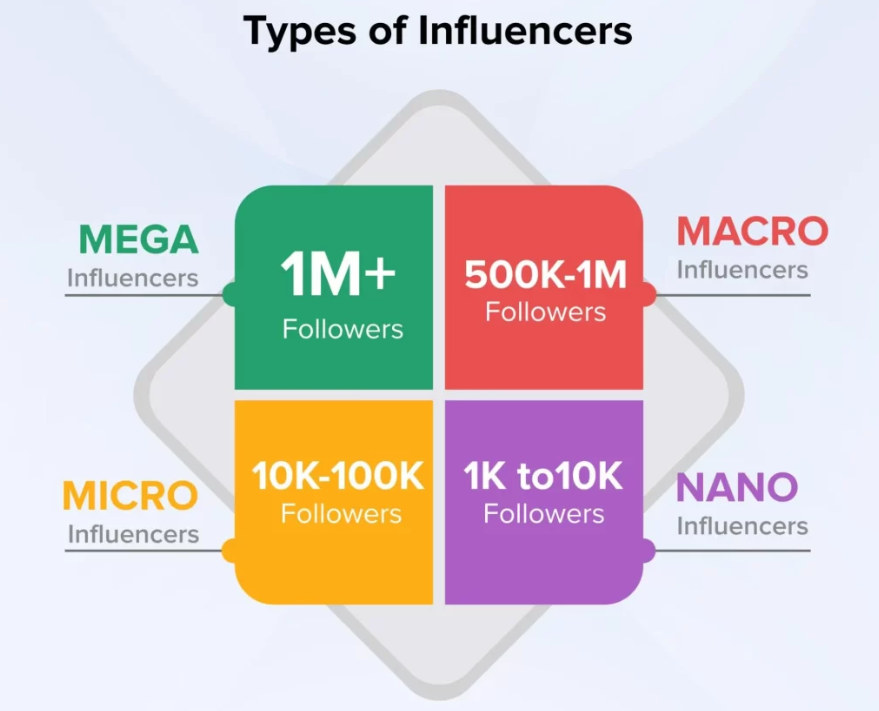
Faceless Content Creators
Faceless influencers share content without ever showing their faces. The trend is quickly gaining popularity as people rethink notions of digital privacy. Faceless content can be effective in specific niches such as cooking, where people are focused on the recipes and how-to processes.
Faceless content does not mean content that lacks personality. Many creators are already discovering ways to be humorous and interesting while delivering value even without focusing on themselves.
If you choose to go for faceless content, you should streamline the message that you want to convey to consumers. Thus, remember to keep it simple and easy to understand. Besides, you should focus on your key messages, benefits and differentiators.
Artificial Intelligence
Several brands are already using AI to support their social media marketing efforts. Content creation is one of the key areas where influencers are using AI. Virtual influencers are increasing gaining popularity and social media channels are also trying out new opportunities for influencers to create AI-powered versions of themselves to interact with audiences and answer their questions.
AI-powered influencers are re-shaping how brands think about partnerships, offering a futuristic twist to conventional influencer campaigns. Although human creators still dominate influencer marketing, AI generated personalities such as Aitana Lopez are carving out space in the industry.
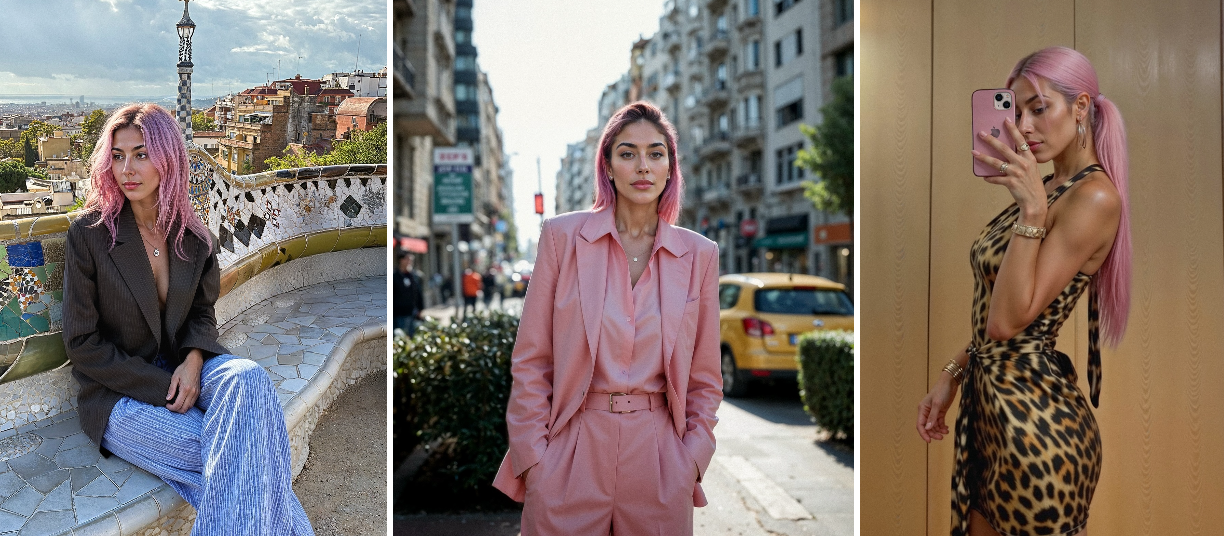
Virtual influencers give brands complete control over messaging, thereby eliminating concerns over reputation risks and inconsistency in branding. Although virtual influencers will not fully replace real influencers, AI-powered influencer campaigns will become a major part of marketing mix.
Artificial Intelligence will likely keep growing in 2025 as a tool for data analysis, building campaigns and measuring results. Although brands and influencers must currently work either off intuition or invest several research hours to build campaign strategies, new influencer tools parse the data and create strategic frameworks so influencers can focus on creativity and audience engagement.
Leveraging AI tools for influencer marketing can be a game changer for marketing agents. That makes influencer discovery, campaign management and performance analysis more efficient and data driven. You can start by using AI to identify influencers who align with your brand’s values, content style and target audience.
Brands can also use AI to analyze data to determine the best audiences or to review campaign performance and point out opportunities for future optimization.
Social Search and Discovery
The social media landscape is no longer just about entertainment; it is becoming a search-first ecosystem. More users, especially Gen Z, use Instagram, TikTok and YouTube like search engines. They are looking for product recommendations, how-to guides and reviews, seeking more in-depth information.
Agencies should optimize influencer content for discoverability and leverage SEO elements like captions, keywords and hashtags to stay ahead. Doing so can significantly boost your chances of ranking higher in search results.
AI-powered recommendations are also reshaping how content is featured. Social media platforms use machine learning algorithms to prioritize content that aligns with user intent. That means agencies should focus on high-value, engagement driven content, making sure it feels relevant and authentic.
Influencer Generated Content (IGC) and User-Generated Content (UGC)
Influencer-Generated Content and User-Generated Content are also among the top influencer marketing trends to watch out for in 2025. Those content types make campaigns to feel more relatable and less like conventional advertising.
IGC builds trust by featuring influencers who integrate products seamlessly into their daily lives. UGC on the other hand, amplifies brand advocacy, with organic customer reviews and testimonials that carry more weight.
LinkedIn Video
LinkedIn’s short-form video feature is creating a more robust content ecosystem for brands and businesses. They are replacing the short-live Stories feature and, can run for up to 60 seconds long. LinkedIn short-form videos are created to give viewers access to professional advice and quick resources to boost their skills or stay updated on industry trends.
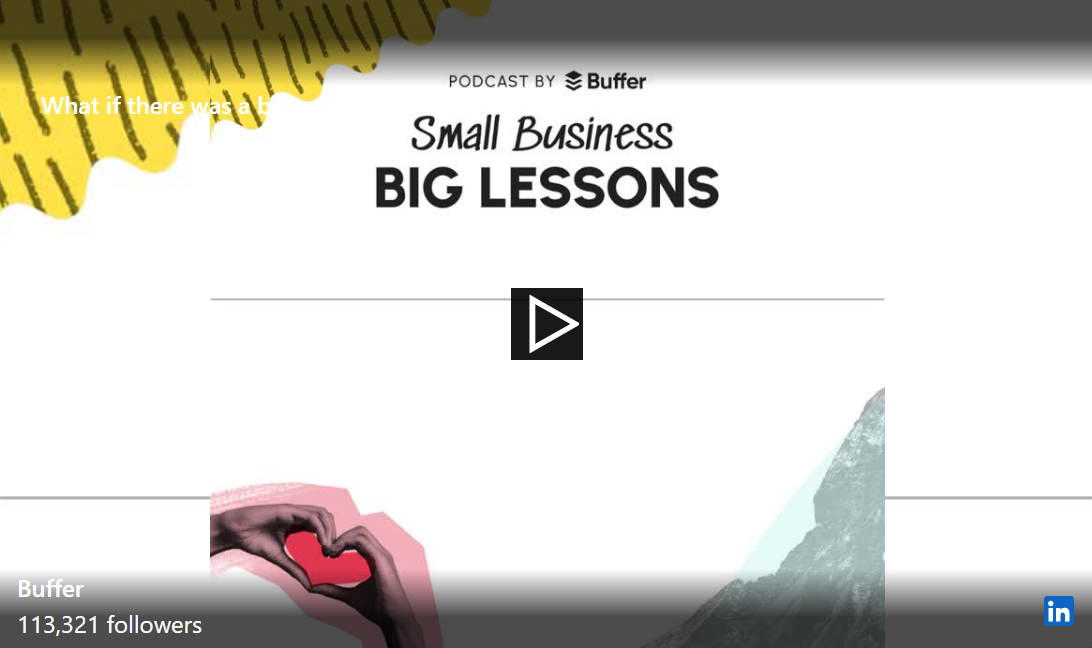
You can leverage the feature to create a more personalized face for your brand. Focus on positioning your brand leaders as thought leaders and experts in your content. It would also be great to work with B2B influencers to create short videos.
Think of LinkedIn’s video feature as a short-form podcast where leaders and influencers can share advice and information as a way of making your brand more approachable. Besides, employee-generated content can also be quite strategic in this channel.
Final Thoughts
Influencer marketing continues to be one of the most effective and connected ways of product promotion, highlighting brand differentiators and driving engagement. As 2025 progresses, influencers will likely play an even more instrumental role in the ways brands connect with their audiences. In case you need help with driving social growth, engage the experts at Superior Social Boost. We help brands and businesses to increase their reach engagement on Facebook, TikTok, Instagram, X, YouTube and Google Business organically.

